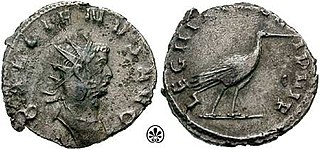 W
WThe Legio I Maximiana was a comitatensis Roman legion, probably created in the year 296 or 297 by the Emperor Diocletian. The legion was named after Maximianus, a colleague of Diocletian. The I Maximiana was formed together with II Flavia Constantia, to garrison the newly created province Thebaidos, in Aegyptus. As well as protect it from neighboring tribes. The legion is also known as Maximiana Thebanorum or Thebaeorum. Since no Legio I Maximiana is listed as being stationed at Thebes in the Notitia Dignitatum, the designation is interpreted more broadly as of the Thebaid in general. The cognomen Maximiana originated from Maximian, Diocletian's colleague. In 354, I Maximiana was in Thrace, in the neighborhood of Adrianople.Thus it is likely that it fought in the Battle of Adrianople, in 378, when emperor Valens was defeated by Goths. According to Notitia Dignitatum, the I Maximiana Thebanorum was still under Thracian command at the beginning of the 5th century, while the I Maximiana was in Philae, under the dux Thebaidos. There exists also a Theban Legion in the legend of Saint Maurice from the 5th century. According to that tradition, this was a legion from Thebes that was ordered to move by Maximian. Thus it is sometimes related to I Maximiana Thebanorum. However, according to tradition, the Theban Legion of Saint Maurice was martyred in 286, while the I Maximiana was not founded until ten years later.
 W
WThe Legio II Flavia Constantia was a comitatensis Roman legion, created by Diocletian, probably in the year 296 or 297.
 W
WLegio II Flavia Virtutis was a comitatensis Roman legion, levied by Emperor Constantius II (337–361), together with I Flavia Pacis and III Flavia Salutis.
 W
WLegio II Italica was a legion of the Imperial Roman army.
 W
WLegio III Augusta was a legion of the Imperial Roman army. Its origin may have been the Republican 3rd Legion which served the general Pompey during his civil war against Gaius Julius Caesar. It supported the general Octavian in his civil war against Mark Antony. It was officially refounded in 30 BC, when Octavian achieved sole mastery of the Roman empire. In that year, it was deployed in the Roman province of Africa, where it remained until at least the late 4th century AD.
 W
WLegio III Diocletiana was a comitatensis Roman legion, levied in 296 by Diocletian, from whom the legion took its name. The aim of this unit was to guard the newly re-organized province of Aegyptus, being based in Alexandria. It was created to support II Traiana Fortis, and therefore it took the numeral III.
 W
WLegio III Italica was a legion of the Imperial Roman army founded in AD 165 by the emperor Marcus Aurelius, for his campaign against the Marcomanni tribe. The cognomen Italica suggests that the legion's original recruits were mainly drawn from Italy. The legion was still active in Raetia and other provinces in the early 5th century.
 W
WLegio V Macedonica was a Roman legion. It was probably originally levied in 43 BC by consul Gaius Vibius Pansa Caetronianus and Gaius Iulius Caesar Octavianus. It was based in the Balkan provinces of Macedonia, Moesia and Dacia. In the Notitia Dignitatum records from beginning of the fifth century, the legion was still stationed in Dacia, with detachments stationed in the east and Egypt.
 W
WLegio VII Gemina was a legion of the Imperial Roman army. It was raised in AD 68 in Hispania by the general Galba to take part in his rebellion against the emperor Nero. "Gemina" means the legion was dedicated to the legendary twin founders of Rome, Romulus and Remus, who were suckled by a she-wolf. The legion was deployed in the city called Legio in AD 74 and remained in Hispania to the end of the 4th century.
 W
WLegio X Gemina, was a legion of the Imperial Roman army. It was one of the four legions used by Julius Caesar in 58 BC, for his invasion of Gaul. There are still records of the X Gemina in Vienna in the beginning of the 5th century. The legion symbol was a bull. Early on in its history, the legion was called X Equestris (mounted), because Caesar once used the legionaries as cavalry.
 W
WLegio XIII Gemina, in English the 13th Twin Legion was a legion of the Imperial Roman army. It was one of Julius Caesar's key units in Gaul and in the civil war, and was the legion with which he crossed the Rubicon in January, perhaps the 10th, 49 BC. The legion appears to have still been in existence in the 5th century AD. Its symbol was the lion.
 W
WLegio XIV Gemina was a legion of the Imperial Roman army, levied by Julius Caesar in 57 BC. The cognomen Gemina (Twinned) was added when the legion was combined with another understrength legion after the Battle of Actium. The cognomen Martia Victrix was added following their service in the Pannonian War c. AD 9 and the defeat of Boudicca in AD 61. The emblem of the legion was the Capricorn, as with many of the legions levied by Caesar.
 W
WLegio I Armeniaca was a pseudocomitatensis legion of the Late Roman Empire. The Legio I Armeniaca was probably founded in the late 3rd century by Julian the Apostate, although it could have been founded by Diocletian It is possible that the name of the legion could mean that it was originally part of the garrison of the Armeniac provinces, but the unit, together with its twin legion II Armeniaca, appears to have been included in the imperial field army. The legion was based in Bezabde until the Persians captured the area in 360. The Legion took part in Julian's invasion of the Sassanid Empire. The Notitia dignitatum records the legion as being under the command of the magister militum per Orientis around 400.
 W
WLegio I Flavia Constantia was a Roman legion, mentioned in the Notitia Dignitatum as a comitatenses unit stationed in the Eastern Empire.
 W
WThe Notitia Dignitatum is a document of the late Roman Empire that details the administrative organization of the Eastern and Western Empires. It is unique as one of very few surviving documents of Roman government, and describes several thousand offices from the imperial court to provincial governments, diplomatic missions, and army units. It is usually considered to be accurate for the Western Roman Empire in the AD 420s and for the Eastern or Byzantine Empire in the AD 390s. However, the text itself is not dated, and omissions complicate ascertaining its date from its content.